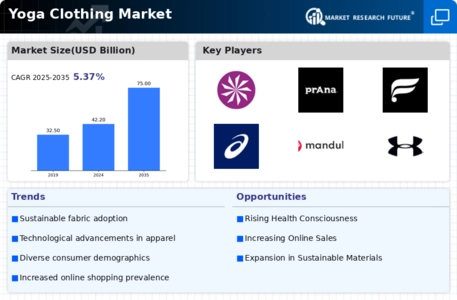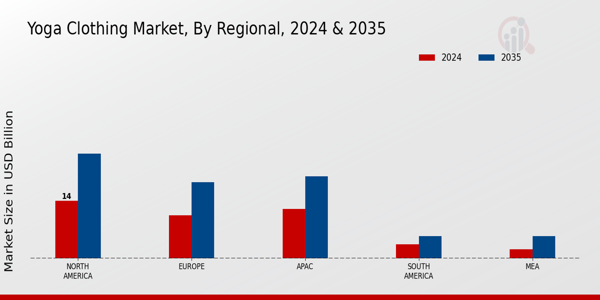Rise of Athleisure Trend
The athleisure trend, characterized by the blending of athletic and leisurewear, significantly influences the Global Yoga Clothing Market Industry. This trend has led to a surge in demand for versatile yoga apparel that can be worn both during workouts and in casual settings. As consumers increasingly seek comfort and style, the market is projected to expand, potentially reaching 75 USD Billion by 2035. This growth reflects a shift in consumer behavior, where clothing is not solely functional but also fashionable. Brands that successfully capitalize on this trend may find substantial opportunities within the Global Yoga Clothing Market Industry.
Market Growth Projections
The Global Yoga Clothing Market Industry is projected to experience substantial growth, with estimates suggesting a market size of 42.2 USD Billion in 2024 and a potential increase to 75 USD Billion by 2035. This growth trajectory indicates a compound annual growth rate (CAGR) of 5.36% from 2025 to 2035, reflecting a robust demand for yoga apparel. The market's expansion is likely driven by various factors, including increased health consciousness, the rise of athleisure, and technological advancements in fabric. These projections highlight the potential for brands to capitalize on emerging trends and consumer preferences within the Global Yoga Clothing Market Industry.
Growing Health Consciousness
The increasing awareness of health and wellness among consumers appears to be a primary driver of the Global Yoga Clothing Market Industry. As individuals prioritize physical fitness and mental well-being, the demand for yoga apparel is likely to rise. This trend is supported by the projected market size of 42.2 USD Billion in 2024, indicating a robust consumer base seeking quality yoga clothing. The emphasis on sustainable and eco-friendly materials further enhances this growth, as consumers become more discerning about their purchases. Consequently, brands that align with these values may experience a competitive advantage in the Global Yoga Clothing Market Industry.
Diverse Consumer Demographics
The Global Yoga Clothing Market Industry is witnessing a diversification of its consumer base, with individuals from various age groups and backgrounds participating in yoga. This broadening demographic spectrum indicates a potential for increased sales across different segments of the market. Brands that tailor their offerings to meet the preferences of diverse consumers, including men, women, and children, may find lucrative opportunities. As the market continues to evolve, understanding the unique needs of these varied demographics will be crucial for brands aiming to establish a strong presence in the Global Yoga Clothing Market Industry.
Increasing Participation in Yoga
The rising participation in yoga practices globally serves as a significant driver for the Global Yoga Clothing Market Industry. As more individuals engage in yoga for its physical and mental benefits, the demand for specialized clothing continues to grow. This trend is reflected in the increasing number of yoga studios and classes worldwide, which further fuels the need for appropriate apparel. The market's expansion is indicative of a broader cultural shift towards holistic health and wellness, suggesting that brands catering to this demographic may experience sustained growth in the coming years. The Global Yoga Clothing Market Industry is poised to benefit from this growing interest.
Technological Advancements in Fabric
Innovations in fabric technology are transforming the Global Yoga Clothing Market Industry, enhancing the performance and comfort of yoga apparel. The introduction of moisture-wicking, breathable, and stretchable materials caters to the diverse needs of yoga practitioners. These advancements not only improve the overall experience for users but also contribute to the market's growth trajectory. As the industry evolves, brands that invest in research and development to create high-quality, technologically advanced products may gain a competitive edge. This focus on innovation is likely to drive the market towards its projected CAGR of 5.36% from 2025 to 2035.















